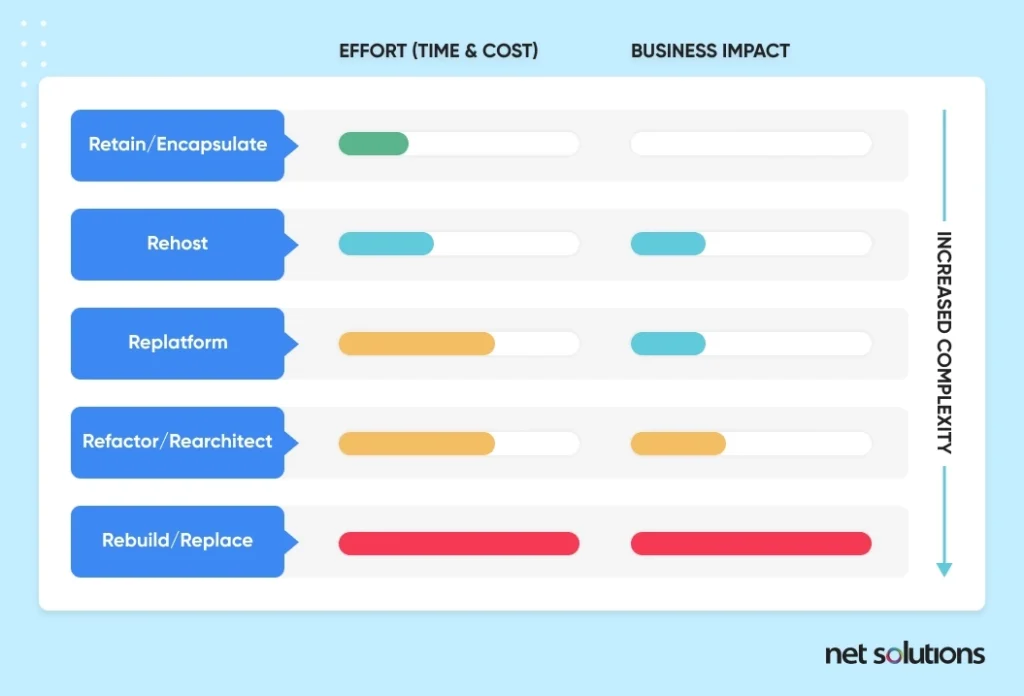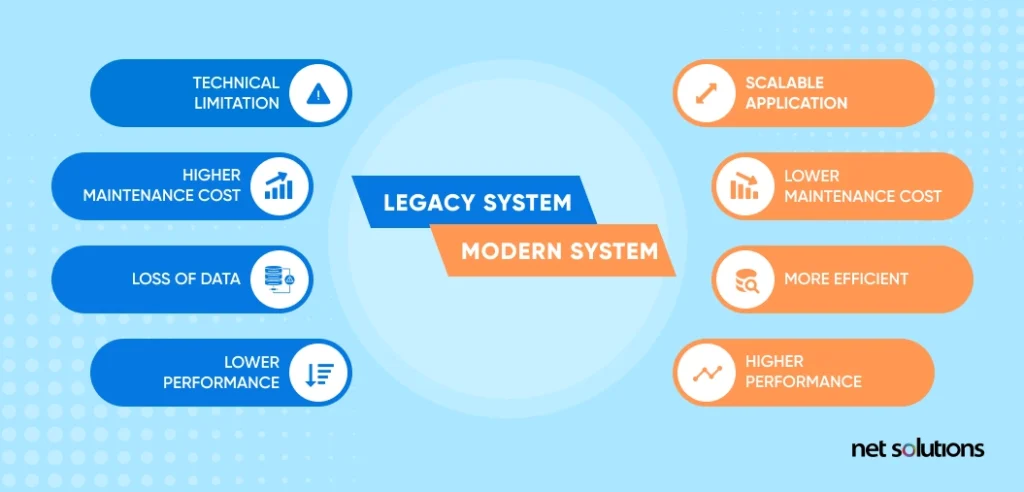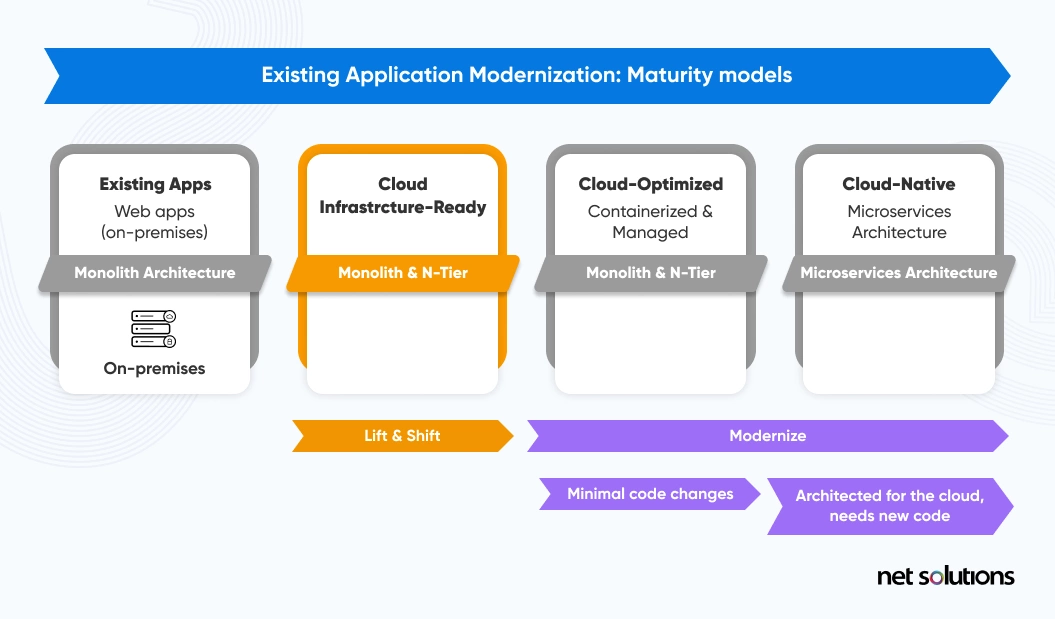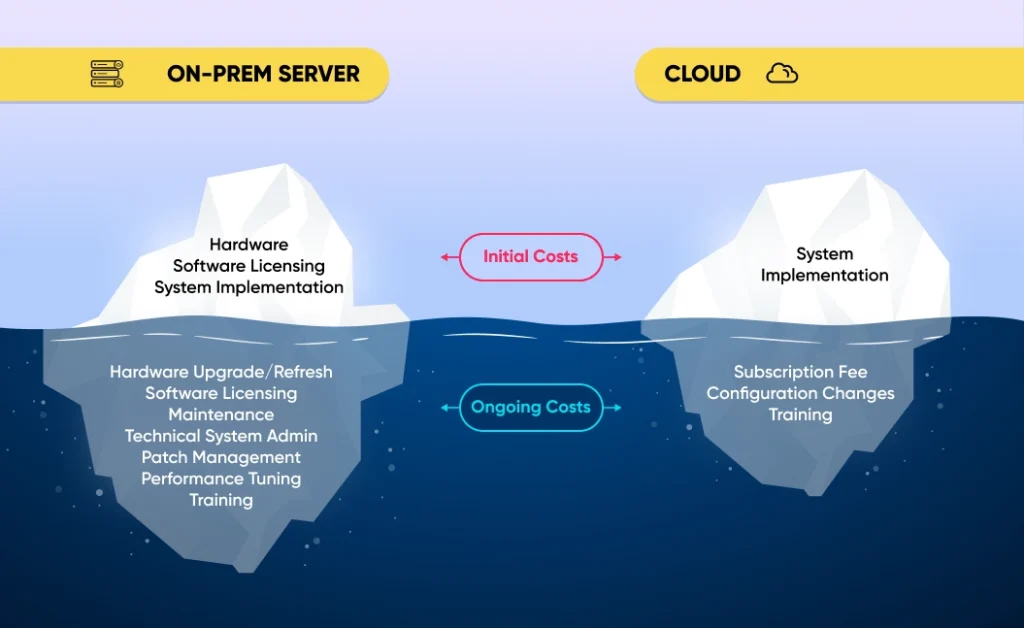Lift and Shift is the most popular method of application modernization. Explore how this approach can help you quickly leverage the benefits of the cloud and future-proof your enterprise for success.
Application modernization is the process of modernizing legacy or older software by adapting or re-writing it to take advantage of new tools, languages, or approaches in the cloud. The goal of application modernization is to deliver a higher-performance, lower-cost application that will be more agile to shifting needs and boost user experience. Prior to the process of application modernization is application rationalization – a strategic effort to identify and assess applications to understand their precise state. It paves the way for deciding whether an application should be retained, retired or modernized.
There are seven ways to approach Application Modernization, known as the “7 R’s”, including the option to Retain, Rehost, Replatform, Refactor, Re-architect, Rebuild, or Retire/Replace, moving from least work / lowest return to most work / highest return.

Along the spectrum of application modernization is the option to “Rehost,” a legacy application, essentially moving components of an existing application from one place to another, e.g., from on-premise to cloud or from one cloud platform to another, while changing very little. This method is known as “lift and shift.”
Lift and Shift: An Introduction
Cloud adoption rates are still rising, with most tech leaders expecting at least half their applications to be moved to the cloud within the next 2 years. However, as McKinsey notes, “there has been a gap between aspiration and execution in cloud adoption” as some cloud migration efforts have been too complex, costly, and time-consuming.
Lift and Shift is an application modernization strategy that allows organizations to move an application and its data to the cloud with minimal work in changing how the application works or looks. This faster, more straightforward approach to application modernization is more likely to deliver immediate returns and is an excellent first step that can later be followed by a more comprehensive application modernization service to maximize long-term returns.
How does Lift and Shift differ from other app modernization strategies?
As part of a comprehensive enterprise cloud strategy, senior executives, CTOs, and other technology leaders are turning to lift and shift to reduce migration complexity, speed time-to-market, reap the cost savings benefits of the cloud, and minimize the risk of disruption to business operations.
To review the difference between Lift and Shift and other application modernization strategies, let’s review the 7 R’r:
- Retain- encapsulate the application in a wrapper and communicate with other systems via API. Fast, but limiting.
- Rehost- move data and applications to the cloud with few changes, our ‘lift and shift” model.
- Replatform- move from a legacy cloud system to a more modern one. Variant: eCommerce replatforming.
- Refactor- also known as “link, tinker, and shift,” small changes are made to optimize a system for performance, scalability, or maintainability.
- Re-architect- when a legacy application is not compatible with the cloud due to its architecture, it makes sense to divide the app into functional components and reassemble it as a microservices-based application in the cloud, making some modifications to each part to optimize the transfer to the cloud.
- Rebuild- rather than just modifying parts, rebuild is a start-from-scratch effort to build an app of the same scope and specifications but with a new code base that can better tap into new cloud features.
- Retire/Replace- go back to the drawing board to completely retire an app or replace it with a whole new one after completing a product development process.
As the above indicates, “Lift and Shift” is the second lightest application modernization approach and is very cost-effective.
Benefits of Lift and Shift

What is the benefit of Lift and Shift? Lift and Shift migration can help you bring your application or workload, along with its data, to a cloud environment with all the same functional capabilities but with the scalability and performance of the cloud. Since it does not require the modification of the application architecture and very little change to its code, this is a very labor-light way to migrate the application and begin leveraging the power of the cloud.
Lift and Shift simultaneously address multiple aspects of the application ecosystem, resulting in a comprehensive modernization approach. Lift and Shift addresses the following:
- Infrastructure modernization Lift and Shift enable the migration of applications to modern cloud-based infrastructure, either public, private, or hybrid, to take advantage of the cost savings and flexibility of the cloud. Whatever be the cloud strategy you choose, benefits of the cloud include low IT overhead, infinite scalability, improved performance, greater resilience to outages, and more manageable security, to name a few.
- Scalability and performance optimization Regardless of the cloud strategy chosen, moving an application to the cloud immediately reaps the benefit of more scalable on-demand resources – benefits that begin to accrue faster because Lift and Shift is such a lightweight modernization approach. Further, Lift and Shift offers the opportunity to run on better, newer hardware without purchasing it, helping improve performance.
- Cost efficiency Lift and Shift can help optimize costs in several ways, first shifting away from CapEx spending by removing the need to own or maintain hardware and shifting that to OpEx spending. Cloud-based resources are based upon pay-as-you-go pricing, with some having elasticity benefits to scale up or down as needed, enabling better utilization.
- Security and compliance Lift and Shift provide an opportunity to strengthen security measures and ensure compliance with industry standards and regulations. Cloud providers have large teams that can stay on top of changing security needs, with the leverage to continually update tools and services around critical areas such as role-based access control and MFA, easier backups and recovery, encryption, and incident detection and response tools.
- Future Modernization Plan According to a survey of senior leaders, lift and shift is the primary cloud migration approach, used by more than half of companies, and is often considered “not the end of the journey,” opening the doors to further modernization after migration toward Cloud Optimized and eventually Cloud Native forms.

Best Practices for Lift & Shift
To ensure the success of a Lift and Shift cloud migration, it is essential to understand the goals of the cloud migration and thoroughly plan the approach.
Key steps for successful Lift and Shift
Follow these Lift and Shift Migration Steps:
- Choose the right cloud service provider
- Understand the dependencies of the app and its data with the broader business ecosystem
- Take the time to set up the cloud to auto-scale and optimize resource spend
- Ensure you have tools to monitor how the app is running and receive alerts if something is awry. Consider tools to improve app resiliency.
- Optimize cloud security
- Test applications thoroughly, optimize as needed
Importance of thorough planning and assessment
Before any migration, analyzing applications for all their dependencies and needs is critical to the success of the shift. Ensure all appropriate stakeholders are involved in the planning, including the development team, user groups, risk management teams, and security/privacy teams. Ask questions such as:
- How long will this application be useful to us?
- In the overall enterprise cloud strategy, what priority is this specific migration?
- What dependencies does this application or its data have?
- Are current API tools capable of the shift to the cloud?
- Does the target cloud platform have cloud migration tools?
- Does the target cloud platform meet your business’s specific compliance requirements?
- Do you have the right team to support the migration? And to support the new cloud environment?
Potential challenges and ways to mitigate them
Any lift and shift approach will hit some roadblocks, so it’s best to know them ahead of time to be prepared with ways to mitigate:
- Scope creep is real- the cloud is new, shiny, and full of possibilities, so it’s very tempting to try to “tweak” the app right away in the first migration. Be aware of this and set a timeline for when new features may be added.
- Gains may be minimal- as a light option, know that Lift and Shift may not always produce immediate returns. Ensure you have a long-term plan to optimize the app.
- Roles may shift- moving to the cloud may result in job loss or the need for new roles and opportunities to support new processes and technology.
- There may be ripple impacts- even with lift and shift, the UX process will shift, or adjustments may need to be made to make the app work as expected. Test, test, test.
Need for collaboration between development and operations teams
Development teams must closely align with operations teams to work in this new cloud environment where change is more agile and collaboration is essential. Creating this cultural shift to DevOps may require some change management to help align people, processes, and tools toward a more unified goal.
Evaluating ROI of Lift & Shift
Lift and Shift migration may not be the right approach in every application modernization effort. It may fail to deliver results if there is a high need for cloud-native features or if the legacy app has significant technical debt that will persist in the cloud. Therefore, it is essential to understand how to evaluate the ROI of the lift and shift process.
How to measure the return on investment (ROI) of Lift and Shift?
To evaluate ROI, you can consider physical hardware costs, operations costs, personnel costs, and any costs associated with migration, integration, and testing.

When is it appropriate to choose Lift and Shift as an option?
Lift and Shift is the ideal option for application modernization when you need to move to the cloud quickly and inexpensively to tap into better cost efficiencies, improved backups, and scalability. The more complex the need for the cloud – the more you want to change – the less this is an ideal long-term solution – but it can be a significant first step!
Signs that Lift and Shift is the right choice:
- Your on-premise costs are high
- You do not have the time or money yet to rebuild the application
- Your application is fairly ‘light’ (i.e., doesn’t have heavy imaging or big-data use)
- You have an off-the-shelf application that simply needs to move to the cloud
- You want to tap into the cloud’s potential for backup and recovery
App Modernization by Net Solutions
Application modernization is a one-and-done process and a journey – particularly with the Lift and Shift model. A comprehensive enterprise cloud strategy can help ensure a future-proof execution of the application modernization process – laying out cloud migration, transformation, adoption, and security strategies.
At Net Solutions, we’ve helped many enterprises leverage the power of the cloud and optimize business upsides with out downtime.
Frequently Asked Questions
1.What is the difference between Lift and Shift and other app modernization strategies?
Lift and shift is the second lightest of the ‘7 R’s’ of application modernization strategies.
2. What considerations should be made when planning a Lift and Shift migration?
A thorough understanding of the app’s strategy and limitations can be a significant first step, followed by understanding which cloud environment is the target and how to get there – are there any migration tools or steps needed to optimize, secure, or set up the target platform? See the above “Best Practices” section for more.
3.Can Lift and Shift be applied to any type of application?
While lift and shift can be used for any application, it is only suitable for some applications – knowing when and where to use it requires careful planning and a comprehensive enterprise cloud strategy. Some applications are so heavily integrated, so old, or no longer useful – so know when to leap.
4. Is Lift and Shift a one-time process, or does it require ongoing maintenance and updates?
Lift and Shift is a process for migrating apps to the cloud. While organizations can choose to migrate part of an app or its data in pieces with lift and shift, this is considered a one-time process that can be followed up by other application modernization efforts to optimize the app. Every cloud application will require ongoing maintenance and updates, regardless of how it got there.
SHARE THIS POST
Table of Contents
Related Resources
- A Framework-based Approach for App Assessment
- App Modernization Benefits To Boost Your ROI and Future-Proof Your Business
- 11 Top Application Modernization Best Practices in 2025
- Building a Winning Application Modernization Business Case
- Legacy Application Modernization Case Studies & Success Stories
- Solving the Toughest Application Modernization Challenges
- Cloud-Native Application Modernization: Benefits & Strategies
- 8 Core Application Modernization Drivers
- Enterprise Application Modernization: Complete Guide [2025]
- Navigating Application Migration and Modernization [Guide]
- Application Modernization and Optimization: A Complete Guide
- A Practical Approach to Application Rationalization: A CIO's Guide to Managing Complexity and Reducing Costs
- What is Replatforming? A Beginner's Guide to Upgrading Your Technology Stack
- 7 Steps to Build an Effective Application Modernization Roadmap
- Application Modernization Services Market: Comprehensive Analysis
- A Step by Step Guide to Application Modernization Strategy
- Explore the Best Application Modernization Tools and Resources
- 13 App Modernization Trends That Can Support and Optimize Your App Modernization Strategy



